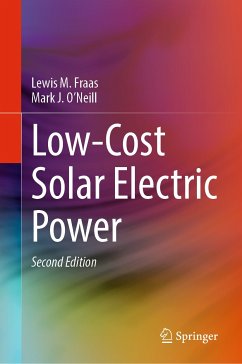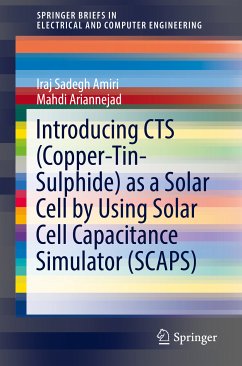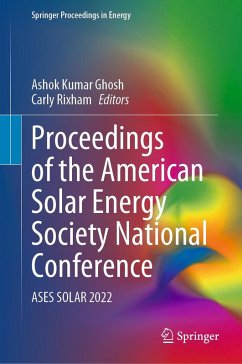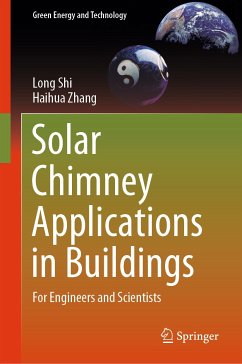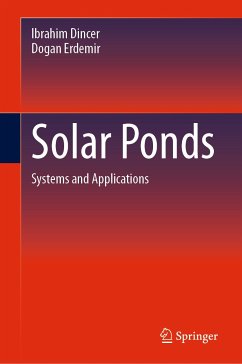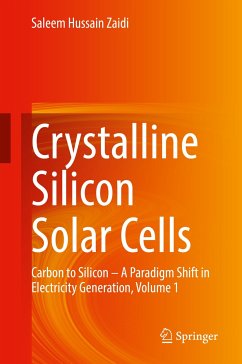
Low-Cost Solar Electric Power (eBook, PDF)
Versandkostenfrei!
Sofort per Download lieferbar
68,95 €
inkl. MwSt.
Weitere Ausgaben:

PAYBACK Punkte
34 °P sammeln!
This book describes recent breakthroughs that promise major cost reductions in solar energy production in a clear and highly accessible manner. The author addresses the three key areas that have commonly resulted in criticism of solar energy in the past: cost, availability, and variability. Coverage includes cutting-edge information on recently developed 40¿ efficient solar cells, which can produce double the power of currently available commercial cells. The discussion also highlights the potentially transformative emergence of opportunities for integration of solar energy storage and natur...
This book describes recent breakthroughs that promise major cost reductions in solar energy production in a clear and highly accessible manner. The author addresses the three key areas that have commonly resulted in criticism of solar energy in the past: cost, availability, and variability. Coverage includes cutting-edge information on recently developed 40¿ efficient solar cells, which can produce double the power of currently available commercial cells. The discussion also highlights the potentially transformative emergence of opportunities for integration of solar energy storage and natural gas combined heat and power systems. Solar energy production in the evening hours is also given fresh consideration via the convergence of low cost access to space and the growing number of large terrestrial solar electric power fields around the world.
Dr. Fraas has been active in the development of Solar Cells and Solar Electric Power Systems for space and terrestrial applications since 1975. His research team at Boeing demonstrated the first GaAs/GaSb tandem concentrator solar cell in 1989 with a world record energy conversion efficiency of 35¿, garnering awards from Boeing and NASA. He has over 30 years of experience at Hughes Research Labs, Chevron Research Co, and the Boeing High Technology Center working with advanced semiconductor devices. In a pioneering paper, he proposed the InGaP/GaInAs/Ge triple junction solar cell predicting a cell terrestrial conversion efficiency of 40¿ at 300 suns concentration. Having become today's predominant cell for space satellites, that cell is now entering high volume production for terrestrial Concentrated Photovoltaic (CPV) systems. Since joining JX Crystals, Dr. Fraas has pioneered the development of various thermophotovoltaic (TPV) systems based on the new GaSb infrared sensitive PV cell. Dr. Fraas holds degrees from Caltech (B.Sc. Physics), Harvard (M. A. Applied Physics), and USC (Ph.D. EE).
Dr. Fraas has been active in the development of Solar Cells and Solar Electric Power Systems for space and terrestrial applications since 1975. His research team at Boeing demonstrated the first GaAs/GaSb tandem concentrator solar cell in 1989 with a world record energy conversion efficiency of 35¿, garnering awards from Boeing and NASA. He has over 30 years of experience at Hughes Research Labs, Chevron Research Co, and the Boeing High Technology Center working with advanced semiconductor devices. In a pioneering paper, he proposed the InGaP/GaInAs/Ge triple junction solar cell predicting a cell terrestrial conversion efficiency of 40¿ at 300 suns concentration. Having become today's predominant cell for space satellites, that cell is now entering high volume production for terrestrial Concentrated Photovoltaic (CPV) systems. Since joining JX Crystals, Dr. Fraas has pioneered the development of various thermophotovoltaic (TPV) systems based on the new GaSb infrared sensitive PV cell. Dr. Fraas holds degrees from Caltech (B.Sc. Physics), Harvard (M. A. Applied Physics), and USC (Ph.D. EE).
Dieser Download kann aus rechtlichen Gründen nur mit Rechnungsadresse in A, B, BG, CY, CZ, D, DK, EW, E, FIN, F, GR, HR, H, IRL, I, LT, L, LR, M, NL, PL, P, R, S, SLO, SK ausgeliefert werden.



